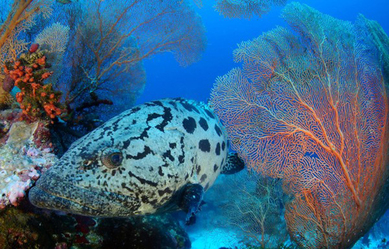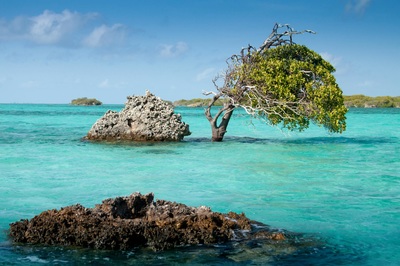|
The ever changing conditions and strict rules also affect the flora in Aldabra... They are coded to survive, even with the tiniest bit of soil around their roots, salt sprays and strong sun.
In addition, similarly to the inner islands, the southeast monsoon provides very little fresh water in the southern atolls. For some of the species the way of adaption is to loose their leaves and going back to the "stand-by". After, when the rains of the northwestern monsoon approach the islands, they start to flourish again. Photos and info source: SIF  Recent video, published by SIF spotlights dugongs at Aldabra. However the atoll is their last refuge in the Seychelles, the featured dugong allowed the SIF team to get quite close. The encounter took place at the lagoon near Ile Esprit. The Animal Diversity Web's summarizes a wide range of information about these mammals. (Photo was made by T Mahoune, and featured on FB, meanwhile the video was edited by AJ Burt) After rereading the Seychelles News Agency's article about 2015's first cabin cruise expedition to the outer islands, we recalled the omnivorous grouper's story.
“One of the most exciting aspects of an expedition cruise is the fact that natural events and sightings can help shape the journey. So it is expected that no two expeditions will be exactly alike, because weather, tides and chance encounters with nature will influence day-to-day activities. The Aldabra lagoon is usually filled to the brim with fish, since the Seychelles Islands Foundation (SIF) which manages Aldabra, has imposed a total ban on fishing near the atoll." Last year a giant brownish grouper - over two metres long - swallowed one of our clients’ underwater cameras. The full article, written by John Lablache and Hajira Amla (A once-in-a-lifetime journey – cruise operator resumes trips to far-flung Aldabra Group, January 15, 2015) is available on the Seychelles News Agency's webpage.  Potato Cod in the Seychelles outer islands, photo by Manu San Felix/ Pristine Seas Potato Cod in the Seychelles outer islands, photo by Manu San Felix/ Pristine Seas The official launching of the 30-minutes long National Geographic film took place last Friday at the STC Conference Room. In September 2014, Bill Clinton, former president of the USA announced, that Seychelles will be one of the destinations of the NatGeo's Pristine Seas project. Only 6 months later, the team of 10, including 4 scientists, arrived to Seychelles to conduct the program: an interesting amalgam of scientific research, popularly presented by the efficient media tools of National Geographic. The result is a viewer-friendly film for any audience, with footage made with deep-cameras, drop-cameras, pelagic cameras and our mini-helicopters for aerial photography. The project's not-hidden aim is to influence decision-makers to protect certain regions of the sea. BBC journalist Paul Rose, the expedition's leader knows the islands profoundly, having been worked for many years on a marine science project in Seychelles. He told in the NSA interview that the coral bleaching events of 1998 really damaged the marine ecosystem, but it is slowly recovering, which shows the health of the Seychelles waters. He also added "… you never see this color of water anywhere else in the world" and during one of the dives, a chief scientist just stopped his work – while recording fish – just to enjoy the dive, rating it as one of his top ten dives in the world. Hajira Amla's article, the "National Geographic expedition leader rates Seychelles ocean, coral health among best in the world" (March 21, 2015) is available on the Seychelles News Agency's webpage. More information and video about the National Geographic expedition is available here. After the 14-nights long Aldabra expedition, MV Maya's Dugong is back to port, with a handful of guests aboard.
|
Archives
October 2017
Categories
All
|
Aldabra Expeditions - Eco and Dive cruise with Silhouette Cruises Ltd
|
LOCATION
|
|







 RSS Feed
RSS Feed